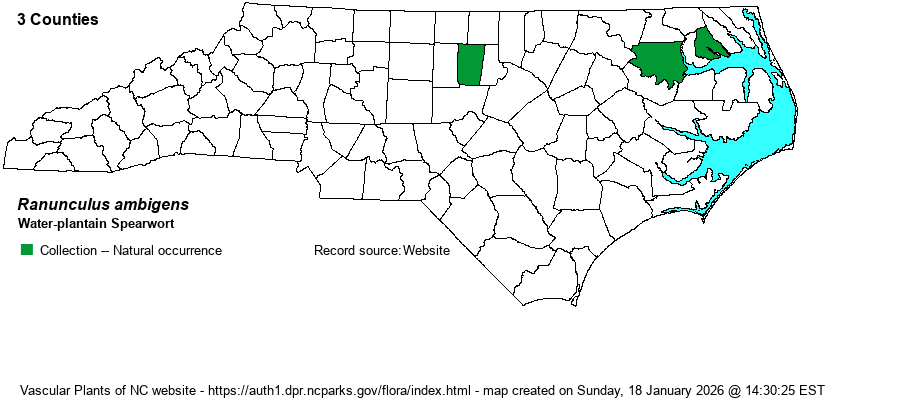| Author | S. Watson | |
| Distribution | Known from only three or four records in the northeastern part of the state -- Perquimans and Bertie counties in 1958, and Orange County in 1963. Sadly, it is long historical in the state.
This is a scarce, Northern species; it ranges from ME and MI south to northern NC and TN.
| |
| Abundance | Of historical occurrence; formerly very rare even into the 1950s and early 1960s, but no known records since 1963. As it is scattered over eastern and central VA, with records from two counties that border NC, it could certainly be re-discovered in the northern part of the state -- especially as counties in the extreme northern Coastal Plain are poorly botanized. It is State listed as Special Concern - Historical. It was formerly given a G4 Global Rank by NatureServe, but a review of recent records has caused them to alarmingly raise the rank to a G2 in 2024. | |
| Habitat | The habitats recorded on the specimens from NC are "ditch", "roadside ditch", and "marshy pasture". This is a species of mostly sunny wetlands, typically in marshes, but also in man-altered sites such as ditches and wet meadows. The species often grows in mud, at times where shaded such as in swamp openings. |
| Phenology | Blooms from April to June, and fruits shortly after flowering. | |
| Identification | This buttercup is quite different from about all of the other 12 native species in NC and should be readily identified if spotted. It has rather robust yet hollow stems, at times rooting from nodes, growing up to 2-3 feet long, generally ascending to somewhat erect. It is a notably "narrow and vertical" species, almost grass-like in appearance at a distance. The leaves (stem) are quite long and narrow, with lower leaves having sheathing petioles (wrapping around the stem); the blades can be 6 inches long and 1 inch wide, being entire and lanceolate. Upper leaves are gradually smaller, but all are slender. At the tips of several branches grow the rather small solitary flowers, with the 5 bright yellow petals about as long as the 5 duller yellow sepals; each flower is about 1/2-inch across. It the species is not seen in bloom, to let the biologist know it is a buttercup, most biologists would pass over the plant, or at least spot it and be puzzled as to what genus or family it might be placed. Considering that it is still present in VA (though presumably declining), and as ditches are quite common everywhere, there is plenty of potential habitat for it to be re-discovered in northeastern NC. | |
| Taxonomic Comments | None
| |
| Other Common Name(s) | Water-plantain Crowfoot | |
| State Rank | SH | |
| Global Rank | G2 | |
| State Status | SC-H | |
| US Status | | |
| USACE-agcp | OBL link |
| USACE-emp | OBL link |

